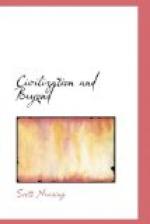Rome’s experiment is sometimes called Graeco-Roman civilization because Greece and Italy were close geographical neighbors and also because Greek culture, which reached its zenith by 500 B.C. and was closely paralleled by the rise of Roman culture, had a profound effect in determining the total character of Roman civilization. In a very real sense Graeco-Roman civilization was the parent of western civilization. Among the many completed civilizations of which we have fairly adequate records, those concerning Rome are most complete and most available.
The story of Roman civilization begins in the Eastern Mediterranean Basin in an era when Greek and Phoenician cities, together with segments and fragments of the Egyptian-Assyrian-Babylonian civilizations were competing for raw materials, trade and alliances. Egyptians had been supreme in the area for centuries. The Sumerian, Aegean, Chinese, Hittite, Assyrian and Indian civilizations had enjoyed periods of dominance but had never reached the level of supremacy enjoyed by the Egyptians.
When Rome came on the scene as a first-rate power, circa 300 B.C., the crucial land bridge joining Africa, Europe and Asia was being passed from hand to hand, with no power strong enough to succeed Egypt as the dominant political-economic-cultural force in the region. Historically speaking it was an interregnum, a period of transition. Egypt had ceased to dominate the public life of the area. The trading cities of the Greeks and the Phoenicians were pushing their way of life into the front ranks among the recognized powers. The kingdoms of Asia-Minor were still warring for supremacy in a field which none of the local kingdoms was able to dominate and hold for any considerable period of time.
Public affairs at the African-European-Asian crossroads were being periodically disturbed and upset by the intrusion of Asian marauders and nomads who came in successive waves, defeated and drove the native inhabitants off from the choicest land and settled down in their places, only to be pushed out in their turn by fresh Asian migrants.
The African-European-Asian triangle was a meeting place and a battle ground. Phoenician and Greek cities brought to this scene new factors and new forces: the rudiments of science; trade and commerce, including a money economy, accounting and cost keeping; the elements of economic organization; the conduct of public affairs by governments based on law rather than on the whim and word of a deified potentate; and the construction of cities and city states built on these foundations.
Rome entered the picture when the forces of political absolutism based upon an agriculture operated by serfs and slaves had fought themselves to a standstill and exhausted their historical usefulness. The times called for new forces capable of adapting themselves to a new culture pattern extending over a greatly enlarged world. The Romans, with their Greek associates, were in a position to fill the gap.




